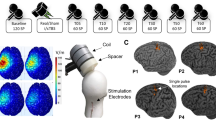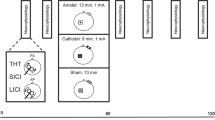Abstract
To investigate whether priming stimulation influences the responses of intracortical inhibitory and facilitatory motor circuits to a subsequent plasticity-inducing inhibitory theta burst TMS paradigm. Using standard transcranial magnetic stimulation (TMS) procedures, MEP amplitude, short-interval intracortical inhibition (SICI), and short-interval intracortical facilitation (SICF) were assessed at baseline and 5, 20 and 30 min following continuous theta burst stimulation (cTBS), intermittent TBS (iTBS), and iTBS-primed cTBS. SICI was assessed using paired-pulse TMS at inter-stimulus intervals (ISI) of 3 ms (SICI3) and the latency corresponding to the latency at which SICF was minimal in each individual. SICF was assessed at ISIs corresponding to Peak 1, Trough 1, Peak 2, and Peak 3 of each individual’s SICF curve. When applied alone cTBS inhibited and iTBS facilitated MEP amplitudes. iTBS-primed cTBS resulted in greater MEP inhibition than cTBS alone. There were no changes in SICF and only marginal changes in SICI following any intervention. Synapses mediating MEP generation undergo modification following iTBS-primed cTBS, possibly through mechanisms related to metaplasticity or synaptic depotentiation. A lack of substantial changes in SICI and SICF under all experimental conditions suggests that the tested rTMS paradigms may be non-optimal for inducing robust modulation of the neural elements mediating SICI and SICF across subjects. Priming stimulation may provide an approach which facilitate neuroplastic change within the human motor cortex at least in circuits responsible for MEP generation.



Similar content being viewed by others
References
Abraham WC (2008) Metaplasticity: tuning synapses and networks for plasticity. Nat Rev Neurosci 9:387–399
Abraham WC, Bear MF (1996) Metaplasticity: the plasticity of synaptic plasticity. Trends Neurosci 19:126–130
Bütefisch CM, Netz J, Weuling M, Seitz RJ, Hömberg V (2003) Remote changes in cortical excitability after stroke. Brain 126:470–481
Chen R, Tam A, Butefisch C, Corwell B, Ziemann U, Rothwell JC, Cohen LG (1998) Intracortical inhibition and facilitation in different representations of the human motor cortex. J Neurophysiol 80:2870–2881
Christie BR, Abraham WC (1992) Priming of associative long-term depression in the dentate gyrus by theta frequency synaptic activity. Neuron 9:79–84
Di Lazzaro V, Pilato F, Saturno E, Oliviero A, Dileone M, Mazzone P, Insola A, Tonali PA, Ranieri F, Huang YZ, Rothwell JC (2005) Theta-burst repetitive transcranial magnetic stimulation suppresses specific excitatory circuits in the human motor cortex. J Physiol 565:945–950
Di Lazzaro V, Pilato F, Dileone M, ProWce P, Oliviero A, Mazzone P, Insola A, Ranieri F, Meglio M, Tonali PA, Rothwell JC (2008) The physiological basis of the effects of intermittent theta-burst stimulation of the human motor cortex. J Physiol 586:3871–3879
Doeltgen SH, Ridding MC (2011) Low-intensity, short-interval theta burst stimulation modulates excitatory but not inhibitory motor networks. Clin Neurophysiol 122:1411–1416
Hamada M, Terao Y, Hanajima R, Shirota Y, Nakatani-Enomoto S, Furubayashi T, Matsumoto H, Ugawa Y (2008) Bidirectional long-term motor cortical plasticity and metaplasticity induced by quadripulse transcranial magnetic stimulation. J Physiol 586:3927–3947
Huang YZ, Edwards MJ, Rounis E, Bhatia KP, Rothwell JC (2005) Theta-burst stimulation of the human motor cortex. Neuron 45:201–206
Huang YZ, Chen RS, Rothwell JC, Wen HY (2007) The after-effect of human theta-burst stimulation is NMDA receptor dependent. Clin Neurophysiol 118:1028–1032
Huang YZ, Rothwell JC, Lu CS, Chuang WL, Lin WY, Chen RS (2010) Reversal of plasticity-like effects in the human motor cortex. J Physiol 588:3683–3693
Iyer MB, Schleper N, Wassermann EM (2003) Priming Stimulation Enhances the Depressant Effect of Low-Frequency Repetitive Transcranial Magnetic Stimulation. J Neurosci 34:10867–10872
Kujirai T, Caramia MD, Rothwell JC, Day BL, Thompson PD, Ferberts A, Wroe S, Asselman P, Marsden CD (1993) Corticocortical inhibition in human motor cortex. J Physiol 471:501–519
Orth M, Snijders AH, Rothwell JC (2003) The variability of intracortical inhibition and facilitation. Clin Neurophysiol 114:2362–2369
Peinemann A, Reimer B, Loer C, Quartarone A, Muenchau A, Conrad B, Siebner HR (2004) Longlasting increase in corticospinal excitability after 1800 pulses of subthreshold 5 Hz repetitive TMS to the primary motor cortex. Clin Neurophysiol 115:1519–1526
Peurala SH, Mueller-Dahlhaus FM, Arai N, Ziemann U (2008) Interference of short-interval intracortical inhibition (SICI) and short-interval intracortical facilitation (SICF). Clin Neurophysiol 119:2291–2297
Quartarone A, Bagnato S, Rizzo V, Morgante F, Sant’Angelo A, Battaglia F, Messina C, Siebner HR, Girlanda P (2005) Distinct changes in cortical and spinal excitability following high-frequency repetitive TMS to the human motor cortex. Exp Brain Res 161:114–124
Rossi S, Hallett M, Rossini PM, Pascual-Leone A (2009) Safety, ethical considerations, and application guidelines for the use of transcranial magnetic stimulation in clinical practice and research. Clin Neurophysiol 120(12):2008–2009
Siebner HR, Lang N, Rizzo V, Nitsche MA, Paulus W, Lemon RN, Rothwell JC (2004) Preconditioning of Low-Frequency Repetitive Transcranial Magnetic Stimulation with Transcranial Direct Current Stimulation: Evidence for Homeostatic Plasticity in the Human Motor Cortex. J Neurosci 24(13):3379–3385
Todd G, Ridding MC (2009) Priming theta-burst repetitive transcranial magnetic stimulation with low- and high-frequency stimulation. Exp Brain Res 195:307–315
Ziemann U, Tergau F, Wassermann EM, Wischer S, Hildebrandt J, Paulus W (1998) Demonstration of facilitatory I wave interaction in the human motor cortex by paired transcranial magnetic stimulation. J Physiol 511(1):181–190
Acknowledgments
MCR holds a Senior Research Fellowship of the National Health and Medical Research Council (NHMRC) of Australia. SHD holds a Postdoctoral Biomedical Research Fellowship of the NHMRC of Australia. This work is supported by a grant from the NHMRC of Australia (Grant ID 565301).
Conflict of interest
The authors declare that they have no conflict of interest.
Author information
Authors and Affiliations
Corresponding author
Rights and permissions
About this article
Cite this article
Doeltgen, S.H., Ridding, M.C. Modulation of cortical motor networks following primed theta burst transcranial magnetic stimulation. Exp Brain Res 215, 199–206 (2011). https://doi.org/10.1007/s00221-011-2886-6
Received:
Accepted:
Published:
Issue Date:
DOI: https://doi.org/10.1007/s00221-011-2886-6




